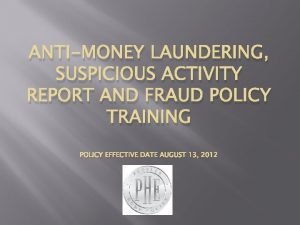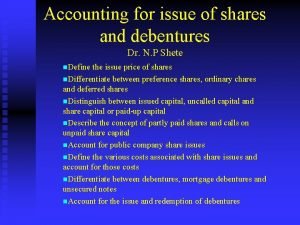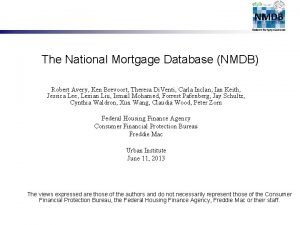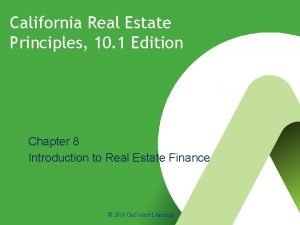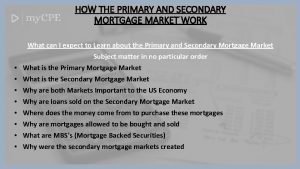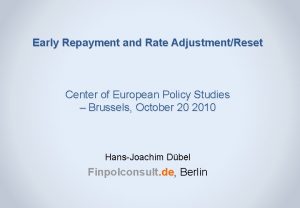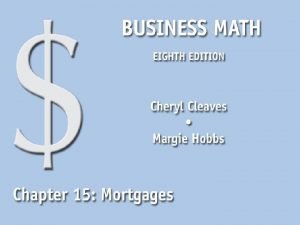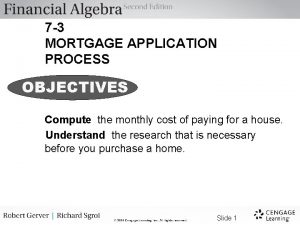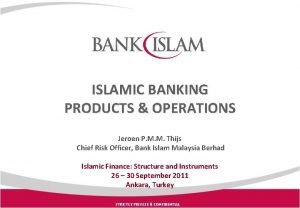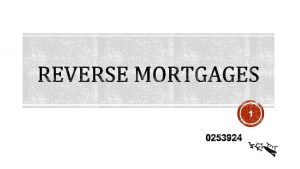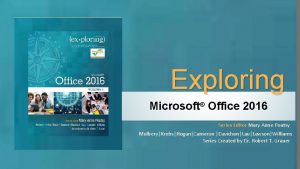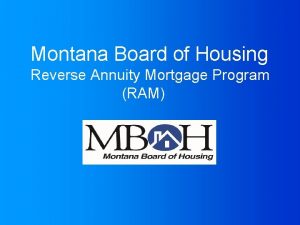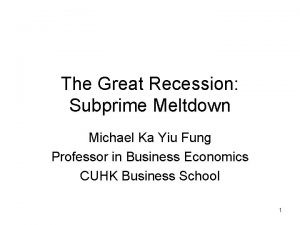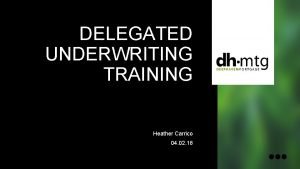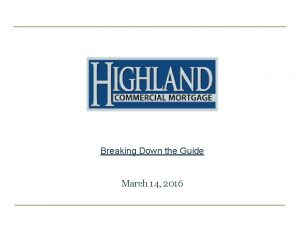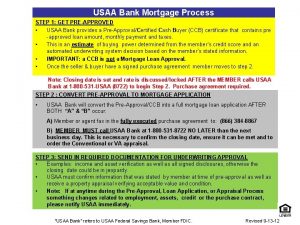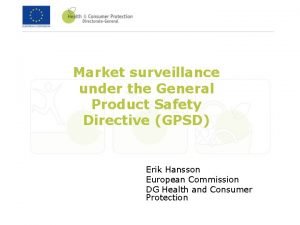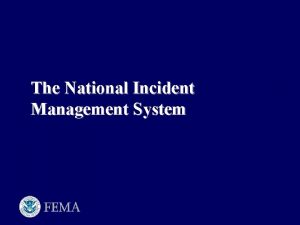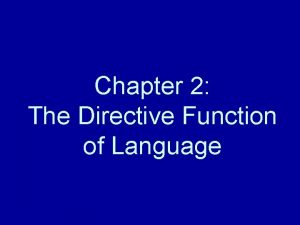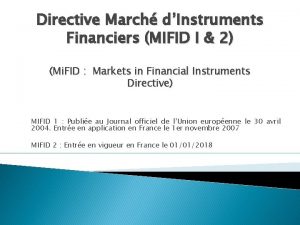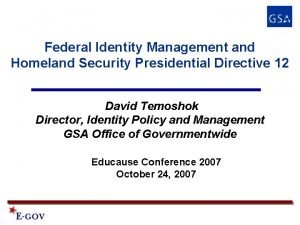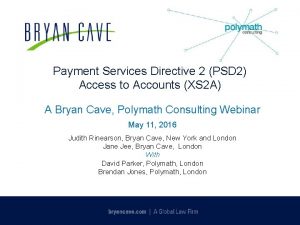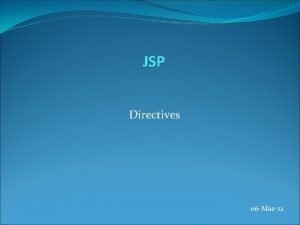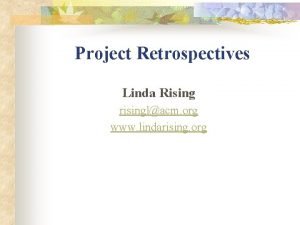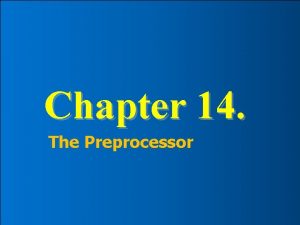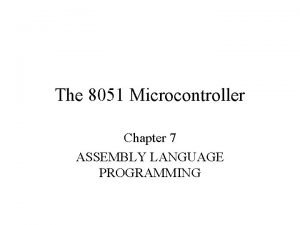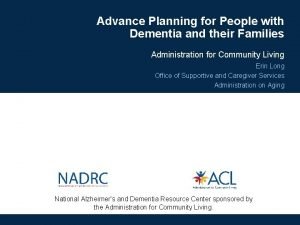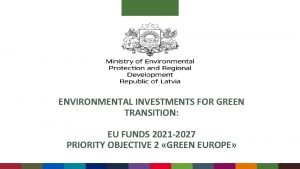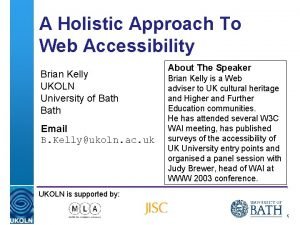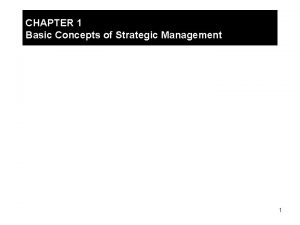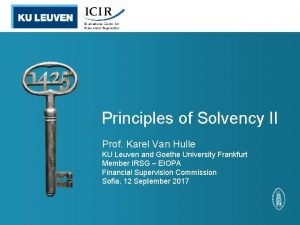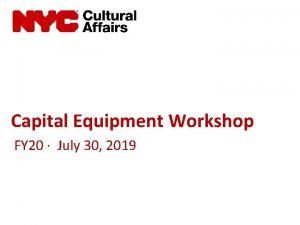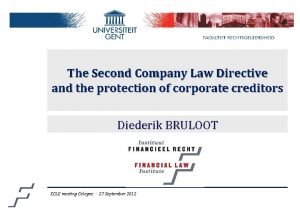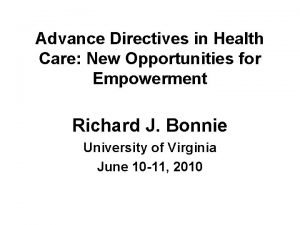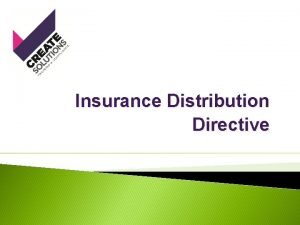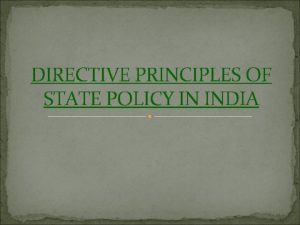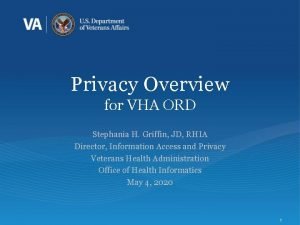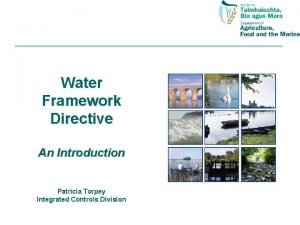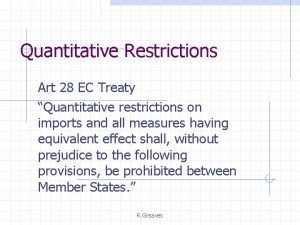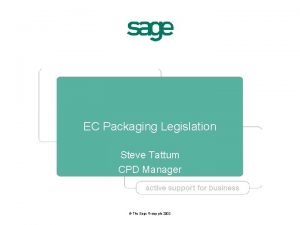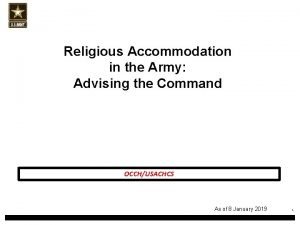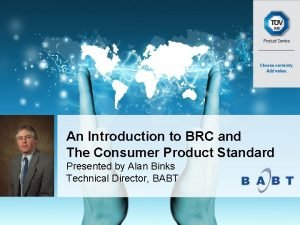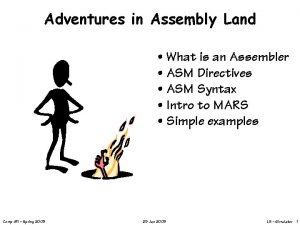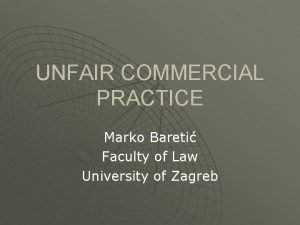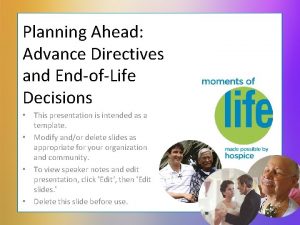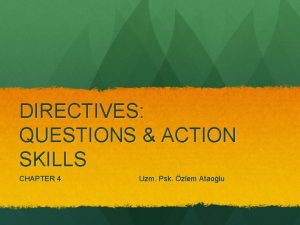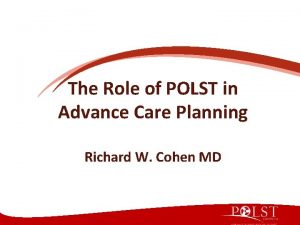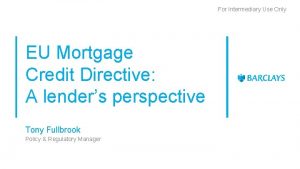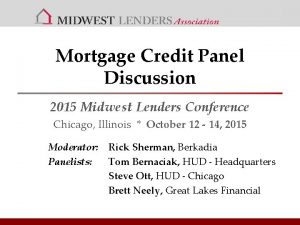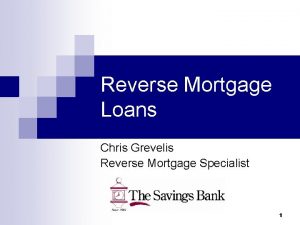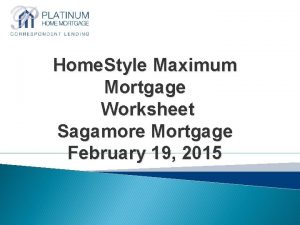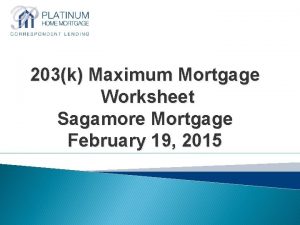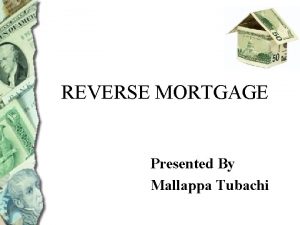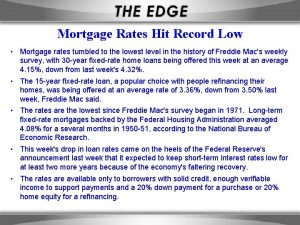Mortgage Credit Directive Conference Mortgage Credit Directive changes






















































































- Slides: 86

Mortgage Credit Directive Conference

Mortgage Credit Directive – changes to the definition of a regulated mortgage contract James Ross | GOUGH SQUARE CHAMBERS

1 Mortgage regulation prior to 31. 10. 04 • Consumer Credit Act 1974 did not cease to apply merely because credit agreement was secured on land / used for purchase of land • Secured loans advanced by certain categories of creditor were exempt under s. 16 of the CCA (e. g. local authorities and building societies) • Many secured loans (especially first charges) exceeded historic monetary limits

2 Regulated mortgage contracts after 31. 10. 04 • FSA regime under the Financial Services and Markets Act 2000 • Regulated activity of entering into / administering a regulated mortgage contract • RMCs exempt from CCA regulation under s. 16(6 C) • Mutually exclusive regulatory regimes operated by the OFT and FSA

3 Original definition of regulated mortgage contract Three stage test for RMC in Article 61(3) of the RAO: 1. Lender provides credit to an individual (or trustees) 2. Secured by first legal mortgage on land in the UK 3. At least 40% of land used (or intended to be used) as or in connection with a dwelling by borrower or related person

4 Interim period from 01. 04. 14 to 21. 03. 16 • Consumer credit regulation transferred from OFT to FCA on 01. 04. 14 • Significant amendments to CCA, FSMA, RAO and introduction of new Consumer Credit sourcebook (“CONC”) • Firms had recently implemented Consumer Credit Directive • Transfer intended to make relatively little substantive changes to existing requirements

5 Mortgage Credit Directive • European Directive on credit agreements for consumers relating to residential immovable property (Directive 2014/17/EU) • Known as “CARRP” or the Mortgage Credit Directive (“MCD”) • UK Government adopted position that MCD added relatively little benefit to consumers but would impose substantial costs on firms • Scepticism that MCD would facilitate a better internal market in mortgage lending

6 Implementation of the MCD • Decision only to make such changes as absolutely necessary • New “appropriate framework” required for buy-to-let mortgages • FCA took opportunity to move second charge lending into mortgage regime • Key implementation date 21. 03. 16

7 Structure of new MCD regime after 21. 03. 16 • Important changes to definition of RMC in Article 61 of the RAO • New Article 61 A setting out exemptions (Simon Popplewell) • Changes to MCOB (Thomas Samuels) • Mortgage Credit Directive Order 2015, including new consumer buy-to-let regime (Ruth Bala)

8 New definition of RMC in Article 61(3) Three stage test has changed: 1. Lender provides credit to an individual or trustees (unchanged) 2. Secured by mortgage on land in the EEA 3. At least 40% of land used (or intended to be used) as or in connection with a dwelling

9 Changes in second stage of RMC test • Wording “first legal mortgage” used in original test has gone • “Mortgage” defined in Article 61(4) as including a “charge” • Second and subsequent mortgages and equitable charges now included within scope • Land can now be anywhere within EEA; not restricted to UK

10 Changes in third stage of RMC test • Original test required at least 40% of the land to be used (or intended to be used) as or in connection with a dwelling by the borrower or a related person • New test merely requires at least 40% of the land to be used (or intended to be used) as or in connection with a dwelling – not necessarily by the borrower or related person • This change brings buy-to-let mortgages within the RMC definition in Article 61 A(3), subject to exemptions

11 Practice points relating to third stage of RMC test • MCOB 1. 6. 3 R requires a firm to take reasonable steps to establish whether a mortgage will be an RMC • What does “in connection with a dwelling” mean? • FCA perimeter guidance referring to gardens and farms (PERG 4. 4. 7 G)

12 Further practice points relating to third stage of RMC test • How does a firm know how the land is intended to be used? • Survey can include confirmation of how land is used • Application process / contract can give rise to estoppel (see Waterside Finance Ltd v Karim [2012] EWHC 2999)

13 RMC test – the negative requirement • In addition to the three stage RMC test, there is a negative requirement • Article 61(3): “…such a contract is not a regulated mortgage if it falls within Article 61 A(1) or 61 A(2)” • Article 61 A sets out various exemptions contract

14 The RMC exemptions • Regulated home purchase plan • Limited payment second charge bridging loan • A second charge business loan • Investment property loan • Exempt consumer buy to let mortgage contract • Exempt equitable mortgage bridging loan • Exempt housing authority loan • Certain second charge credit union loans

15 Temporal application of the new RMC test • Article 61(5) of the RAO deals with timing • Contracts made before 21. 03. 16 can only be an RMC if: a) they fell within Article 61(1) at the time; or a) the contract is a “consumer credit back book mortgage contract” within the meaning of article 2 of the Mortgage Credit Directive Order 2015

16 Consumer credit back book mortgage contracts • General intention was to bring existing regulated secured consumer credit agreements within the FCA mortgage regime • A “back book” contract will fall within the new RMC test if it was a regulated consumer credit agreement when made and would have satisfied the new RMC test if it had been in force • Ongoing duties under MCOB will therefore generally apply to back book mortgage contracts after 21. 03. 16

17 Transitional provisions for the back book • Transitional provisions for “consumer credit back book mortgage contracts” are contained in Article 29 of the MCDO • General intention was that borrowers would not lose any CCA protections as a result of the transfer of the back book into the FCA mortgage regime • Where a back book contract was void or unenforceable before 21. 03. 16, it will remain so (albeit subject to existing mechanisms for obtaining relief) • Certain CCA protections will continue to apply (e. g. interest not to be increased on default, rebate on early settlement) • Unfair relationships provisions in sections 140 A and 140 B of the CCA continue to apply

18 Article 3(1)(b) agreements • Article 3(1)(b) provides that the MCD applies to “credit agreements the purpose of which is to acquire or retain property rights in land or in an existing or projected building” • Article 3(1)(b) agreements fall outside the RMC test • Likely to need CCA permissions for entering into Article 3(1)(b) agreements • Article 3(1)(b) agreements need to comply with MCOB 14

19 What next? • Recent changes relating to consumer credit and then MCD have left regulatory regime in a poor state • FCA review of retained provisions of the CCA by 01. 04. 19 • Brexit unlikely to make much difference in short to medium term • Parliamentary counsel are likely to be in short supply

20 Any questions? E-mail: james. ross@goughsq. co. uk

Mortgage Credit Directive Exemptions Simon Popplewell | GOUGH SQUARE CHAMBERS

25 The exemption provisions > Article 61 A contains a number of exemptions to a contract being a regulated mortgage contract > However, these are only exemptions from being a RMC. > An agreement that would otherwise be a RMC but for Article 61 A would still be a credit agreement. Therefore will need authorisation under Article 60 B of the RAO unless there is an applicable CCA exemption > Need to also take into account CBTL provisions.

26 Article 72 I RAO > Any consumer buy to let mortgage business carried on by a registered consumer buy to let mortgage firm which relates to an agreement entered into on or after 21 st March 2016 is excluded from > Articles 25 A (advising on RMCs); > 36 A (credit brokerage); > 53 DA (advising on regulated credit agreements for the acquisition of land); > 60 B (credit agreements); and > 61 (RMCs) > Not all activities in relation to CBTLs exempt. For example debt collection and debt administration still potentially applicable.

27 The RMC exemptions > Article 61 A of the RMC > Regulated home purchase plan > Limited payment second charge bridging loan > A second charge business loan > Investment property loan > Exempt consumer buy to let mortgage contract > Exempt equitable mortgage bridging loan > Exempt housing authority loan > Certain second charge credit union loans

28 Regulated home purchase plan > A way to buy a home without paying interest - Islamic mortgages > Is an authorised activity under article 63 F of the RAO

29 Limited payment second charge bridging loan > Must satisfy the 3 stage test for being an RMC > It is a borrower lender supplier agreement financing the purchase of land > It is used as a temporary financial solution while transitioning to another financial arrangement for the land subject to the mortgage > The mortgage is a second or subsequent charge > The number of payments to be made is not more than 4

30 Second charge business loan >Must satisfy the 3 stage test for being an RMC; >Credit is over £ 25, 000; >2 nd or subsequent charge; and >The agreement is entered into by the borrower wholly or predominantly for the purposes of a business carried on, or intended to be carried on, by the borrower

31 An investment property loan > Must satisfy the 3 stage test for being an RMC > Less than 40% of the land is used, or intended to be used, as or in connection with a dwelling by the borrower or a related person (or beneficiary of trust); and > The agreement is entered into wholly or predominantly for the purposes of a business carried on, or intended to be carried on, by the borrower

32 The business test >There is provision in Article 61 A(3) for a business purposes declaration > This is not compulsory > Can be rebutted if the lender know or had reasonable cause to suspect not entered into for business purposes > Wood v Capital Bridging Finance Ltd [2015] EWCA Civ 451 >In respect of buy to let mortgage contracts is to be regarded as a business “for the purposes of this article” if > the borrower or a related person has never lived in the property (and is not intended to in the future); or > The borrower has more than one rental property >This is not a test found in the MCD >Can the buy to let test be used for CCA exemptions?

33 Exempt consumer buy-to-let mortgage contract > Is a consumer buy-to-let mortgage contract; and > Is outside the scope of the mortgages directive because of article 3(2) of that directive; or > Is a bridging loan

34 What is outside the scope of the mortgage directive > Equity release credit agreements (defined in MCD) > Employer to employee loans interest free or with rates of interest lower than generally available on the market > Interest free agreement where no other charges except the cost of securing the credit > Overdraft facilities where the overdraft has to be repaid inside a month > Credit agreements which are the outcome of a settlement reached in court or before another statutory authority > Article 3(2)(b) credit agreements which relate to the deferred payment, free of charge, of an existing debt

35 Bridging loan >Has the same meaning as Article 4(23) of the MCD >“a credit agreement either of no fixed duration or which is due to be repaid within 12 months, used by the consumer as a temporary financing solution while transitioning to another financial arrangement for the immovable property” >Recital 15 : “[credit agreements] whose purpose is to provide temporary financing between the sale of one immovable property and the purchase of another” >What about: > Where there is to be a sale of the old property, so no new financial arrangement? > Where there is not to be a sale of the old property, but rather renovation of the existing property?

36 Exempt equitable mortgage bridging loan > A contract that is a bridging loan > Is secured by an equitable mortgage on land; and > Is an exempt agreement within the meaning of article 60 B(3) by virtue of article 60 E(2) > E. g. a local authority or a person specified in rules made by the FCA (charities, friendly societies etc)

37 Exempt housing authority loan > Credit is to be provided by a housing authority; and > Is a bridging loan; or > Outside scope of the MCD; or > A restricted public loan within the meaning of article 60 HA (i. e. general interest enactment test) in respect of which the borrower receives timely information on the main features, risk and costs at the pre-contractual stage, and any advertising is fair, clear and not misleading

38 Credit Union Loans >Must be a “limited interest second charge credit union loan” > i. e. borrower lender > 2 nd or subsequent charge > Lender is a credit union > Rate of interest not exceed 42. 6% >Borrower receives timely information on the main features, risks and costs of the contract at the pre-contractual stage; and >Any advertising of the contract is fair, clear and not misleading

39 Pre-existing exemptions >Article 62 – Arranging administration by an authorised person (administering RMCs only) >Article 63 – Administration pursuant to agreement with an authorised person (administering RMCs only)

40 CCA exemptions >Over £ 25 k and for business purposes >Buy to let exemption in Article 60 D (less 40% used as dwelling by borrower and secured) but not applicable to Article 3(1)(b) agreements >Agreements relating to purchase of land where lender is a local authority, or specified by the FCA but subject to Article 60 HA >12 payments or less inside 12 months and secured or interest free >Low interest borrower lender loans, but for Article 3(1)(b) agreements only if meet general interest test, and given timely information on main features risks and costs of agreement and advertising is clear fair and not misleading >high net worth debtors but subject to Article 60 HA >Article 60 HA – precludes exemptions not permitted under MCD.

41 Article 3(1)(b) agreements > Likely to need CCA permissions for entering into article 3(1)(b) agreements > This is despite the fact that article 3(1)(b) agreements cannot be regulated consumer credit agreements (they are excluded by s. 8 of the Consumer Credit Act 1974) > Whilst this looks strange, it is deliberate > Article 3(1)(b) agreements need to comply with MCOB 14

Type MCD CCA CBTL Need to be registered to be exempt – Article 72 I Islamic mortgage Exempt (but need authorisation anyway) – Article 61 A(1)(a) Exempt (but need authorisation anyway)Article 60 C(2)(b) 4 payments bridging loan Exempt – Article 61 A(1)(b) Exempt – Article 60 F(4) (bridging loan so 60 HA not applicable) 2 nd charge business loan over £ 25 k Exempt – Article 61 A(1)(c) Exempt – Article 60 C(3) (not inside MCD because not a consumer) Investment property loan Exempt – Article 61 A(1)(d) Exempt - Article 60 D (not inside MCD because not a consumer)

Type MCD CCA Exempt consumer buy to let mortgage contract Exempt – Article 61 A(1)(e) Exempt – Article 60 D (not inside MCD because this a requirement of being exempt equitable buy to let mortgage contract) Exempt equitable mortgage bridging loan Exempt – Article 61 A(1)(f) Exempt – Article 60 E(2) (not inside MCD because bridging loan) Exempt housing authority loan Exempt – Article 61 A(1)(g) Exempt – Article 60 E(5) (note typo in article– “relevant agreement”) Exempt Credit Union Loans Exempt – Article 61 A(2) Exempt – Article 60 G(2)

44 Thought process > Am I secured on land? > If not then not an RMC. > BUT, am I acquiring or retaining an interest in land? > is the customer a consumer ? > if yes, Article 3(1)(b). CCA exemptions unlikely to be applicable > Am I a CBTL? If yes, need to be registered CBTL > Is there a MCD exemption? If not then RMC > Is there an applicable CCA exemption? Should be if an RMC exemption

45 Examples > A barrister wants to borrow money to pay his tax bill. The loan is secured over his home

46 Examples >A dentist borrows £ 400, 000 to purchase a second rental property. He uses the rental income to pay for his children’s school fees

47 Examples >A greengrocer borrows money to pay for his daughter’s wedding. He borrows this money by securing his loan against his greengrocer’s shop

48 Examples >A father borrows money to help his son buy a car. The loan is secured over the son’s flat (which the father owns)

49 Examples > A mother borrows money to help her daughter find the deposit for her first flat. The mother will be a co-owner of the flat to help obtain the mortgage. The loan for the deposit is unsecured

MCOB CHANGES Thomas Samuels| GOUGH SQUARE CHAMBERS

Regime Change

52 Overview of changes > Created single set of processes and procedures > Whether a consumer is taking a “traditional” mortgage or a second charge loan, the process will now be the same > 1 st charge lenders have had to adapt (although they are used to MCOB) > Key changes (for advisors/lenders/administrators): > MCOB > Training and Compliance (TC) > Prudential Sourcebook for Mortgages (MIPRU) > It means a more regimented regime

Amendments to MCOB rules

54 Overview > The key changes are the insertion of 8 new chapters in the MCOB rules > The new sections mirror what is already in MCOB but relate specifically to obligations for MCD regulated mortgage contracts > eg: MCOB 5 is “Pre-application disclosure” and MCOB 5 A is “MCD Preapplication disclosure” > Some of the MCD sections are additional to the non-MCD provisions (e. g. MCOB 4 A) > 1 st charge lenders will be familiar with at least the set-up of the rules > 2 nd charge lenders (who have moved from CCA) potentially face an entirely different regulatory landscape

55 MCD process Customer approach Binding offer 7 day reflection Initial disclosure /AE Application ESIS MCD RMC (inc. any post-sale disclosure)

56 MCOB 2 A: The Mortgage Credit Directive > This is a general overview of some of the behavioural expectations > These are things which derive directly from the MCD and had no preexisting equivalent either in MCOB or CCA > Best characterised as general consumer protection measures > For example: > When establishing remuneration for members of staff concerned with affordability, appropriate risk management must be in place (MCOB 2 A. 1. 2) > General prohibition on “tying practices” save in specific circumstances (MCOB 2 A. 2. 1)

57 MCOB 3 A. 5: “MCD Financial Promotions” > MCOB 3 A is a pre-existing chapter on “Financial Promotions” > New section at MCOB 3 A. 5 on MCD financial promotions > MCOB 3 A. 5. 1 applies where the promotion indicates an “interest rate or any figures relating to the cost of the credit…” > Must then indicate various information in a “clear, concise and prominent way”, including: > Identity of creditor > That agreement will be secured > APRC > “where applicable” term, installments, total amount payable, etc. > Information must be given on basis of a “representative example” – i. e. figures expected to be applicable to 51% or more of customers responding to FP > Also general info required by MCOB 3 B (similar to FPs) – “available at all times on paper”

58 MCOB 4 A: “Additional MCD advising and selling standards” > This is additional to the obligations in MCOB 4 (the key of which is initial disclosure obligations at MCOB 4. 4 A) > Key obligation is MCOB 4 A. 2: “Adequate explanations” > Must be given orally or in a durable medium before any binding offer is issued to a customer “to enable the customer to assess whether [the mortgage] meets their needs and financial situation” (MCOB 4 A. 2. 1(1)) > Includes (MCOB 4 A. 2. 1(2)): > PCI – including European Standard Information Sheet (“ESIS”) > Essential characteristics of product proposed > Specific effects it may have on the customer (including in default) > How and when the adequate explanations are to be given is situation specific (MCOB 4 A. 2. 2) > If advisory services are provided a record of the recommendation must be provided to the customer on paper – can be by way of ESIS (MCOB 4 A. 3)

59 MCOB 5 A: “MCD Pre-application disclosure” > This is the key new provision of the MCD regime – introduces and details the ESIS document > The provisions are there to ensure that a customer has information about the features and price of product so that (MCOB 5 A. 1. 2): > they can make “an informed decision” > information is disclosed in “a consistent way to facilitate comparison between providers” > It is equivalent to a SECCI > Linked is the rule that a customer cannot enter into a MCD regulated mortgage contract unless they have specifically applied for it (MCOB 5 A. 2. 1) > Combination of the two ideas means that a would-be borrower can: > Shop around pre-application > Apply for a particular product > Ensure that offers correspond with applications > Generally, MCOB 5 A places no restriction on literature which is not specific to the amount the customer wants to borrow (eg marketing literature – but it may still be a FP!) (MCOB 5 A. 3. 9)

60 MCOB 5 A cont. : general requirements for an ESIS > Per MCOB 5 A. 3. 1 -7 an ESIS must be: > Accurate > Issued only to who are or might be eligible for the product > Emphasised as an important document to be read carefully > In a durable medium > A firm must keep a record of all ESIS issued to customers to be retained for one year (MCOB 5 A. 3. 13 -16) > A firm “must” provide the ESIS before the customer makes an application, unless it has already been provided (MCOB 5 A. 4. 1) > Must also be given whenever any of the following occur unless already provided (MCOB 5 A. 4. 1(2)): > When advice is given to enter into a particular MCD contract > When a customer requests an ESIS > When in an execution-only sale the customer has indicated which MCD mortgage contract they wish to enter into > In any event, “without undue delay” when the customer has given all necessary information as to needs financial situation and preferences and in “good time” before being bound by offer/contract (MCOB 5 A. 4. 1(3))

61 MCOB 5 A cont. : content of the ESIS > Must be in the form set out in Annex 1 to MCOB 5 A (MCOB 5 A. 5. 2) > It must do, inter alia, the following (MCOB 5 A. 5. 3): > Replicate the text > Fill in information in square brackets > Be completed in accordance with Annex 2 to MCOB 5 A > Be in a single document > Be clearly readable > Use bold/larger/underlined font for the highlighted text > Highlight all risk warnings > It must contain “only the material prescribed… and no other material” (MCOB 5 A. 5. 5) > Additional info can be provided but “must” be “in a separate document” (MCOB 5 A. 6. 1)

62 MCOB 5 A cont. : content of the ESIS (2) > The form to be followed is in Annex 1, to be completed in accordance with notes in Annex 2 > Credit intermediary details(Part 2) - Needs to be completed only where the credit intermediary “provides an ESIS to the customer” (Annex 2, ¶ 4. 1) > A lot of emphasis in the MCD (and various sections on ESIS) relating to more complex structural products: > Foreign currency loans (e. g. Kásler [2014] Bus LR 664) > eg. Have to include warnings foreign currency loans about movement in exchange rates and a cap on the maximum amount the consumer will have to repay (Annex 2, ¶ 5. 2) > Interest included in Part 4 – provision for reference rates and interest-rate spreads; web address on where base rate can be found (eg. EURIBOR, Bank of England) (Annex 2, ¶ 5. 6)

63 MCOB 5 A cont. : content of the ESIS (3) > Interest also includes costs incorporated into APRC: > costs to be a paid on a one-off basis (eg. admin fees) > costs to be paid regularly (eg. drawdown fees) > costs not known to the creditor (eg. ? !) > Emphasis on potential rise and fall over long term > Applies to variable interest rates (Part 4) and amount of installments (Part 6) > If there is an IR cap – assumption that it rises to that cap as soon as possible (Annex 2, ¶ 6. 6(2)) > If there is no IR cap – increase is by reference to high in ERR over last 20 years or longer period of data available, or highest value of benchmark rate specified by FCA or “another competent authority” (Annex 2, ¶ 6. 6(3)) > Table to assist with calculation of additional (“maximum”) APRC (Annex 2, ¶ 6. 12)

64 MCOB 6 A: disclosure at the offer stage > MCOB 6 A is post-ESIS and application when an offer is made > Also applies if the terms of existing MCD regulated mortgage are being varied (MCOB 6 A. 1. 2) > When an offer or variation is made the firm must give a “binding offer” set out in an “offer document” and another copy of ESIS (MCOB 6 A. 2. 1 -2) > This gives the customer the 7 day reflection period before accepting the deal (MCOB 6 A. 3. 4) > Purpose of the reflection period is to allow consumer “sufficient time to compare offers, assess their implications and make an informed decision” > Binding offer can still be subject to conditions, e. g. no change of circumstances or material non-disclosure (MCOB 6 A. 3. 3) > Record must be kept of all offers made (MCOB 6 A. 3. 8)

65 MCOB 6 A: disclosure at the offer stage (2) > No prescribed format > Must contain the following (MCOB 6 A. 3. 9): > Period of validity > If there are features of offer which might increase debt, eg. scope for additional borrowing, amount by which it would increase > When any interest rate changes might occur and explanation of any annual review system > Consequences if offer not accepted, eg. fees forgone > That once accepted there will be no right of withdrawal > Notice of “right” to repay in accordance with terms > Repayment strategy information (MCOB 6 A. 3. 11) needs to only be included for “interest-only” mortgages (because of definition of “repayment strategy” in Glossary) > If lender knows debt is going to be assigned / sold must state that and give name of assignee and, if known, who will be responsible for setting interest rate (MCOB 6 A. 3. 17 -19) > Tariff of charges must either be integral in offer document or accompany it separately (MCOB 6 A. 4. 1 & 3)

66 MCOB 7 A-B: disclosure post-sale > Post –sale there are on-going disclosure requirements through a “durable medium” (MCOB 7 A. 2) > Includes: > Interest rate changes > Information on early repayment (if customer notifies firm they wish to do so) > Warning on currency fluctuations (where greater than 20%) > Notification in “good time” of actual or likely (interest-rate) changes resulting from auctions on capital markets > Where there is to be a further advance a new ESIS must be provided and APRC must be based on “amount of further advance only” (MCOB 7 B. 1)

67 MCOB TP 1: MCD Transitional Provisions > Transitional provisions have depended upon nature of the firm and the obligation under consideration > Key on-going transitional provisions are for 1 st charge lenders: > Can opt out of MCOB 5 A, 6 A and 7 B (i. e. ESIS, binding offer document and further advance requirements) until 21 March 2019 (TP 1, ¶ 45) > However if they do so, must also provide (TP 1, ¶ 46): > For foreign currency loan, the warning required by section 6 of MCOB 5 A, Annex 1 > The 7 day reflection period required by MCOB 6 A. 3. 4 > For variable rate loans: > warning and additional APRC required by section 4 of MCOB 5 A, Annex 1 > Maximum installment illustration required by section 6 of MCOB 5 A, Annex 1

68 MCOB TP 1: MCD Transitional Provisions (2) > Various other requirements in TP following on from ¶ 45 > Information in TP 46 must be given no later than when the illustration is provided (per MCOB 5, 6 and 7) > Can be done within the illustration or separately in a durable medium > Requirement that information in relation to MCD mortgage must be provided free of charge (MCOB 2 A. 6. 1) does not apply to contracts entered into before 21 March 2016 that would be MCD regulated if entered into from 21 March 2016 > Can switch to the “full” MCD regime at any time

Amendments to other Handbook rules

70 Training and Competence (TC) > This has been updated to ensure that firm’s employees are trained and competent in relation to MCD-regulated products > Have been added to the list of products and competencies listed in Appendix 1 (TC 2. 1) > There is a transitional period which runs until 21 March 2019 (TC TP 9, ¶ 9. 2): > Effectively disapplies TC 2. 1. 5 C (which requires assessment on professional qualifications & training/competency testing) > May assess knowledge and competence of an employee solely on the basis of their professional experience

71 Prudential Sourcebook for Mortgages (MIPRU) > Certain changes to MIPRU to cover “Insurance the MCD mediation activities” > Extends rules those undertaking MCD intermediation activities, eg. allocation of responsibility to a director or senior manager (MIPRU 2. 2. 1) > MIPRU 2. 3 (“Knowledge, Ability and Good Repute”) is not extended to MCD > Relevant professional indemnity protections required for MCD intermediaries is set out in MIPRU 3. 2. 9 B (MIPRU 3. 2. 9): > 460, 000 Euros for each individual claim > 750, 000 Euros per calendar year for all claims

72 Any Questions? ? > Any questions? > thomas. samuels@goughsq. co. uk

Consumer BTL Mortgages Ruth Bala GOUGH SQUARE CHAMBERS

74 Overview National Framework Page 75 - 78 Register and Conduct Standards Page 79 - 81 Special Business Purposes Test Page 82 - 84 Broking CBTL Mortgages Page 85 - 87

National Framework CBTL regime

76 National Framework Mortgage Credit Directive 2014/17/EU > MCD covers consumer residential and BTL lending > Member states had discretion not to apply MCD to BTL; > must then develop “national framework” > CBTL regime represents UK’s framework: secondary system of regulation; > Only around 11% of BTL mortgages are CBTLs; > Majority of BTL mortgages will be for business purposes > exempt from regulation as IPLs

77 Definition of CBTL Mortgage Definitions: RMCs, BTLs and CBTLs > Amended definition of RMC: > Removal of requirement that security dwelling is occupied by the “borrower” (or his relative) > RMCs can now be secured on homes occupied by 3 rd party tenants; > CBTL is a species of RMC; > MCDO art 4 definition of BTL mortgage: > RMC where the contractual terms provide that the security property must be rented as a dwelling by a 3 rd party > CBTL is a BTL mortgage not entered wholly/predominantly for business purposes

78 Exclusion from Regulated Activities RAO Art 72 I Exclusion > CBTLs are type of RMCs > therefore entering or administering CBTLs is prima facie RAO art 61 regulated activity; > RAO art 72 I exclusion: covers variety of regulated activities, incl art 61; > Exclusion offered to firms undertaking “CBTL mortgage business”, provided they are on the Register; > If on the Register, you will not be undertaking a regulated activity by entering a CBTL (even though it is an RMC) > Exclusion extended to firms “administering” CBTL mortgages in later draft

Register and Conduct Standards

80 CBTL Register Authorised or Unauthorised Firms > The FCA “must” enter authorised firms on the Register if they apply properly; > i. e. firms which already have Part 4 A permission re another activity > Authorised firms carrying on CBTL business without being on the Register are contravening a “requirement”; > Unauthorised firms may be entered on the Register if they meet fitness requirements; > Unauthorised firms carrying on CBTL business without being on the Register are contravening the general prohibition (criminal offence)

81 Conduct Standards > Firms on CBTL Register must comply with MCDO Sch 2 requirements > e. g. conduct of business, staff competence requirements, pre-contract illustrations, obligations re interest rate changes, arrears and repossession > MCOB inapplicable to CBTLs (CBTL business is not a regulated activity, so not a ‘home finance activity’) > ‘Unfair Relationships’ is applicable to CBTLs and BTLs; > s 140 A(5): inapplicable where exempt under RAO art 60 C(2); > Nov 15: art 60 C(2) amended so exemption catches firms carrying on art 61(1) regulated activity > initial draft art 60 C(2): exempt if RMC – this would have covered CBTLs, so UR inapplicable

Special Business Purposes Test

83 Proof or Presumption > Mere receipt of rental income from 3 rd p insufficient to make lending business purposes (otherwise concept of CBTL could not exist); > Two alternative routes: > Proof (statutory business purposes test MCDO art 4(4), with 2 alternative limbs) > Presumption (Business Purposes Declaration) > Art 4(4) test: Route (a): at time of purchase, borrower had/has intention to let security property to 3 rd p and it has never been his home; > Part of definition of BTL mortgage is that the contract provides that the security property will be let to a 3 rd p (so borrower must simply have “intention” reflecting this term); > Effectively, this means all BTLs financing the purchase of the property will be business purposes > Route (b): borrower already owns another BTL

84 Examples > BTL mortgages which will usually be for business purposes (so exempt): > Loan is used to finance purchase of BTL property; > Loans secured on previously purchased properties: > Property has always been BTL since purchase > Borrower has another BTL > Typical CBTLs (secured on previously purchased properties): > Borrower previously lived in property, but was unable to sell it, so lets it instead; > BTL mortgages secured on inherited property (cannot satisfy route (a) as property not “purchased”) > Content

Broking CBTL Mortgages

86 Art 25 A: Arranging RMCs > Pre-MCDO: BTL mortgages were unregulated, but broking BTLs was RAO art 36 A regulated activity; > Post-MCDO: broking business purposes BTLs is not RAO art 25 A regulated activity (they are exempt as IPLs, so not RMCs) > What about broking CBTLs? > Art 72 I exclusion covers art 25 A; applies to “CBTL mortgage business” > MCDO art 4: “CBTL mortgage business” incls acting as “credit intermediary” > Therefore CBTL “credit intermediaries” will be excluded from RAO art 25 A activity if on the Register

87 Mere Introducers > BUT art 5 definition of “credit intermediary” expressly excludes brokers which are “mere introducers” > Therefore mere introducers are not undertaking “CBTL mortgage business” and cannot rely on art 72 I exclusion > Can it safely be assumed that a mere introducer is not “making arrangements” for the purposes of RAO art 25 A? > See FCA Glossary definition of “making arrangements” > Commentary Encyclopaedia FS Law > But it would be strange for a mere introducer to be subject to more stringent regulatory requirements than a full intermediary; > If CBTL mortgage is brokered by an unauthorised mere introducer, and this contravened the general prohibition, there would be no effect on enforceability
 Mcc tax credit
Mcc tax credit Changes in latitudes, changes in attitudes meaning
Changes in latitudes, changes in attitudes meaning Physical change chemistry
Physical change chemistry What happened in chapter 10 of animal farm
What happened in chapter 10 of animal farm This can be avoided by giving credit where credit is due.
This can be avoided by giving credit where credit is due. How to suppress a caivrs report
How to suppress a caivrs report Paul allen mortgage
Paul allen mortgage Coverage consultation grafton
Coverage consultation grafton Mortgage chunking definition
Mortgage chunking definition Debentures accounting
Debentures accounting Bian capability model
Bian capability model Math 1050 mortgage project
Math 1050 mortgage project Nmdb
Nmdb Deephaven mortgage reviews
Deephaven mortgage reviews Gpam mortgage loan
Gpam mortgage loan Primary vs secondary mortgage market
Primary vs secondary mortgage market Huecu mortgage rates
Huecu mortgage rates Rafiq's monthly mortgage payment
Rafiq's monthly mortgage payment Reo management solutions llc
Reo management solutions llc 7-3 mortgage application process
7-3 mortgage application process Salam contract
Salam contract Prospect mortgage
Prospect mortgage Townsend mortgage company excel
Townsend mortgage company excel The hong kong mortgage corporation limited
The hong kong mortgage corporation limited Powerhouse mortgage solutions
Powerhouse mortgage solutions Difference between hypothecation and mortgage
Difference between hypothecation and mortgage Mortgage rate
Mortgage rate Mortgage in suncrest
Mortgage in suncrest Angel oak ms
Angel oak ms General surveying services
General surveying services Mortgage hedging 101
Mortgage hedging 101 Mboh loan servicing
Mboh loan servicing Mortgage backed securities diagram
Mortgage backed securities diagram Deephaven mortgage reviews
Deephaven mortgage reviews Highland commercial mortgage
Highland commercial mortgage Approved mortgage solutions
Approved mortgage solutions Jason arkell
Jason arkell Mortgage compliance services
Mortgage compliance services Chfainfo.your mortgage online.com
Chfainfo.your mortgage online.com Usaa home loan pre approval
Usaa home loan pre approval Absa home loans
Absa home loans General product safety directive
General product safety directive Three reasons to use supportive stance
Three reasons to use supportive stance Presidential directive 5
Presidential directive 5 Verbal escalation continuum cpi
Verbal escalation continuum cpi Article 95
Article 95 Directive language
Directive language Mi directive
Mi directive Presidential directive 51
Presidential directive 51 Proposal for a directive on adequate minimum wages
Proposal for a directive on adequate minimum wages Xs2a meaning
Xs2a meaning Ltorg in system programming
Ltorg in system programming Rare consequential and directive
Rare consequential and directive Jsp directives
Jsp directives Eu marine strategy framework directive
Eu marine strategy framework directive Norm kerth retrospective prime directive
Norm kerth retrospective prime directive Directive control examples
Directive control examples Management directive 715
Management directive 715 8051 microcontroller assembly language programming
8051 microcontroller assembly language programming Npl directive
Npl directive Advance directive vs polst
Advance directive vs polst Waste framework directive
Waste framework directive Sup directive
Sup directive Eu web accessibility directive
Eu web accessibility directive A strategic decision is rare, consequential, and directive.
A strategic decision is rare, consequential, and directive. Web accessibility directive
Web accessibility directive Solvency ii
Solvency ii Directive 10 nyc
Directive 10 nyc Second company law directive
Second company law directive Uva advance directive
Uva advance directive Difference between guidance and counselling
Difference between guidance and counselling Directive behavior
Directive behavior Insurance distribution directive summary
Insurance distribution directive summary Sanction behind directive principles
Sanction behind directive principles Directive 86/609/eec
Directive 86/609/eec Vha directive 1123
Vha directive 1123 Enthusiastic beginner disillusioned learner
Enthusiastic beginner disillusioned learner Patricia torpey
Patricia torpey Geddo case
Geddo case Packaging and packaging waste directive
Packaging and packaging waste directive Army directive 2016-34
Army directive 2016-34 Rtte directive
Rtte directive Extern assembler directive
Extern assembler directive Unfair commercial practices directive
Unfair commercial practices directive Advanced directive
Advanced directive Directive question examples
Directive question examples Advance directive
Advance directive








